Bento 101 (Getting Into the Bento Making Habit): Part 2b: The right kind of bento box for you
Welcome back to the 3rd lesson in Bento 101: Getting Into the Bento Making Habit. If you've been following along, by now you should have a list of foods you like to eat that you consider to be packable for lunch, as well as experimented with putting a meal in a box. If you're just joining us, there's still plenty of time to catch up!
In Part 2b we're going to continue thinking about the all important question of the container or containers we want to bring our lunches in. The type of container that is ideal for you depends primarily on the types of foods you want to bring for lunch. This is one of the main reasons why I had you make a list of foods that you'd like to pack for lunch in Assignment 1. The food you want to pack should dictate the type and size of container you need, not the other way around.
So let's look at the container types to consider.
The Japanese style bento box

Japanese and Japanese-style (since not all boxes of this time are actually made or designed in Japan these days) bento boxes are a marvel of compactness and portability, and are available in a wide variety of designs, colors, materials and price ranges. And let's face it, they are the most fun to collect. (Take a look at my visit to Hakoya, the largest bento box maker in Japan for example, to see the care they take in making even mundane plastic boxes.) Japanese style bento boxes are available in sizes ranging from around 250ml capacity (about 1 US cup) to 1000ml for single-person use. Most bento accessories such as silicone cups for dividing up your food inside the box are sized for Japanese bento boxes.
One third to one half of a typical Japanese bento box is packed tightly with rice. Besides the rice there are usually various other foods called okazu that go with the rice, also packed in tightly so that the food doesn't shift around when the box is in transit.
This is a classic Japanese style bento (how-to here):
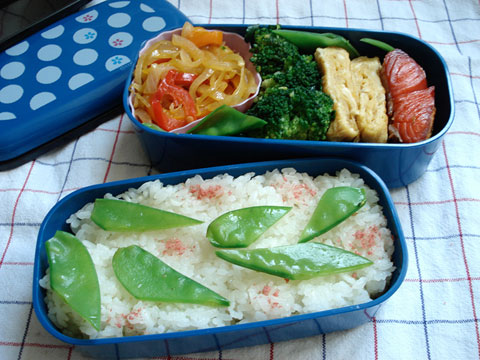
If you like Japanese style bentos anyway, naturally the bento boxes designed to hold them are ideal for you. They're also well suited for any kind of meal that's based on some sort of cooked grain or beans, not just rice. Think of couscous, quinoa, barley, lentils, whole wheat berries, a mixed bean salad...the list goes on. The larger sizes are great for pasta salads that use short pasta, as well as potato salad and so on.
Here's a fairly small bento box filled with quinoa and beans (how-to here):

Here's a pasta salad in a larger-size (around 700ml) Japanese-style (but not actually Japanese) box (how-to here):

Most of my boxes are Japanese bento boxes, since most of the bentos I pack (as well as the ones featured on this site) are based around cooked grains or legumes of some sort.
The bento size guide is especially useful for this style of box. In most cases you'll be packing your lunches tightly using the 'third dimension' as we covered in the previous lesson, so if you haven't done that assignment yet I'd encourage you to do so before going shopping for the bento box that's right for you.
One thing to note about Japanese style bento boxes is that they are designed to be carried upright in your bag, with the lid facing up. There are even 'slimline' boxes that can be packed upright in a briefcase. This means that your lunch will not leak out in most cases, especially if you choose a box with a sealing lid. Most modern bento boxes have sealing lids, but a few don't, such as traditional wooden boxes. These just need to be carried with extra care if you pack something leaky in them. Furoshiki or square cloth wrappers are traditionally used to wrap around such bento boxes tightly. (If you're crafty, take a look here for long time JustBento friend Bronwyn Carlisle's instructions for making your own furoshiki.) An American box like the LunchBots line which have non-sealing lids can also be used like this with leaky foods. There are also dedicated bento box bags, some of which are insulated.
Thermal bento containers/lunch jars
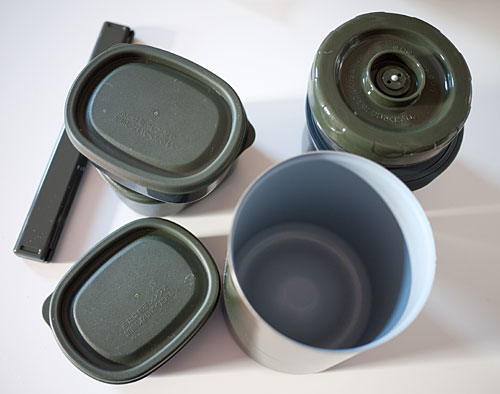
Thermal containers are great if you like the idea of a hot stew or soup for lunch, and don't have access to a microwave at lunchtime. I took an in-depth look at themal containers here.
Personally I am not the biggest fan of the large, bulky thermal lunch jars like Mr. Bento, just because they're rather heavy and bulky. I prefer to use small thermal lunch jars for the hot/liquid stuff, paired with a regular bento box for the other things. But The Guy (aka my husband) loves his Mr. Bento, and I know that the all-in-one solution has a lot of fans.
This is a meatball stew bento that The Guy made using a thermal lunch jar set. (how-to here).
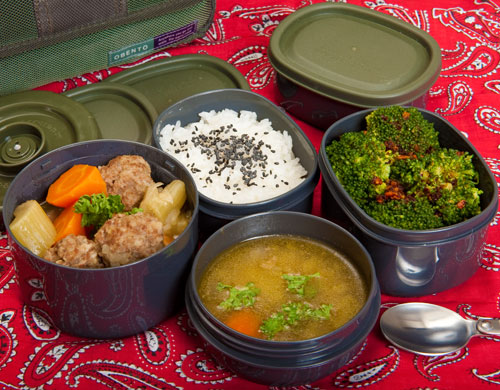
Larger containers or multi-containers for fluffy food lovers
By "fluffy food", I mean food that needs quite a lot of space and air around them, that would suffer if pressed into a compact container - in other words, things like salads and sandwiches. There are two approaches to this type of lunch packing situation: to choose large, roomy containers, or to use multiple containers.
For sandwiches, I often make a 'deconstructed' version, where the bread is packed separately from the fillings and are assembled just before eating, like the deconstructed bahn mi bento, where I've used a regular Japanese style bento box to pack the fillings plus extra salad:
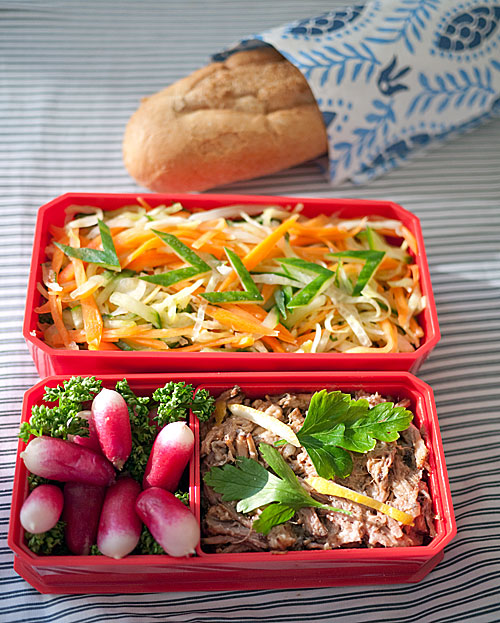
For this even simpler deconstructed sandwich I also used a regular Japanese-style box for the fixings:
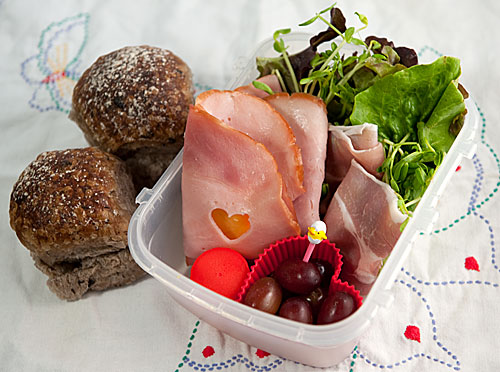
Here's another deconstructed sandwich, where I used a bento box that is way too small (at around 350ml capacity) for a regular bento, but works great to hold the fillings for a sandwich plus fruit
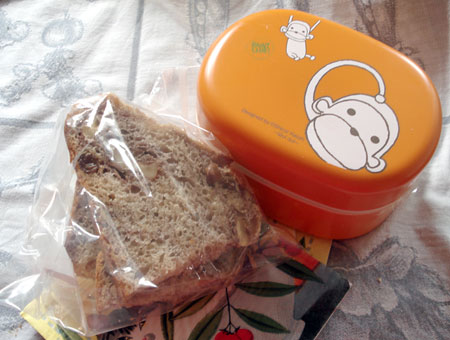
If you'd rather bring an assembled sandwich though, there are plenty of sandwich containers out there, from the plain plastic bag plus brown bag combination on up.
If you like eating leafy salads and the like you will need a larger container, and the sizing guidelines listed above won't really apply to you. While there are dedicated 'lunch containers' for this purpose, you'll find the a much bigger choice by looking at regular food containers. The larger, deeper size of Ikea 365 container for instance is not too bulky, but is deep enough to hold a good amount of salad - and you can use the smaller capacity models in the same line as side boxes.
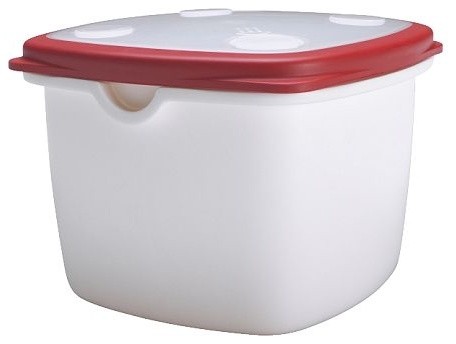
You could also pack a salad lunch in multiple smaller boxes as Idid here - the leafy greens in one box, a potato salad in the smaller box.
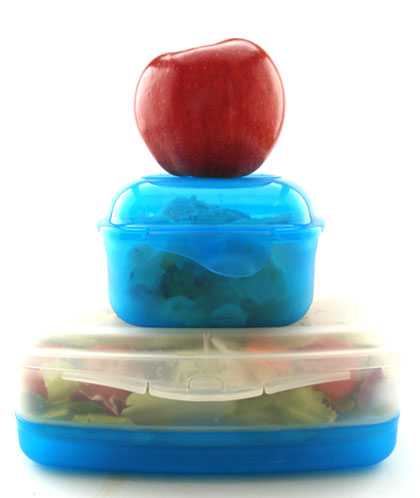
Fixed compartment lunch carriers
There's another category of lunch container that I haven't discussed too much on these pages, and that's the large, multi-compartment type of carrier, such as the Goodbyn Lunchbox or the PlanetBox. The advantage to these containers is that initially they seem easy to use since the compartments are so well defined. I am not sure if any were inspired by the muffin tin lunch movement, but I wouldn't be surprised since the concept is similar.
The drawbacks that all of these containers share is that they are quite large and bulky, and can only logically be carried vertically unless you have a shopping bag or something with a very big bottom. If you have food a very 'wet' food with sauce or something in there, if you carry it vertically there are good chances it's going to leak, no matter how leakproof the manufacturers claim their carriers are. They usually try to prevent leaking by fitting these containers with tightly fitting lids that may or may not be hinged, but it's hard to fight against the laws of gravity. Most Japanese style bento boxes are designed to be carried upright with the lid facing up, so they are much less likely to leak.
Therefore, in my opinion the large, flat lunch carrier is most suited for people who do not pack 'leaky' foods. If your lunch style is some cut up fruit and vegetables with hummus or cheese cubes and some nuts and raisons and so on - which is the kind of lunch that tends to be featured in the marketing materials for these containers - then they are great.
(Note: I'm not sure what to make of the current form factor of the Laptop Lunches line, which I now notice are being marketed as 'bento boxes'. I seem to recall they used to be bigger in height and width, but now it looks like theyv'e made them smaller h x w wise and deeper. The current stated size is 9" x 7", which could be carried upright at the bottom of a roomy backpack. Any Laptop Lunch owners out there that want to comment?)
Choose the right material
This chart of bento box/container materials shows you the pros and cons of each type. For instance, glass is great if you are looking for something that is plastic-free (although the lids are usually some sort of plastic) and dishwasher and microwave save, but does have the considerable disadvantage of being breakable, as well as heavy. Stainless steel is dishwasher safe and plastic-free, but can't go in the microwave. Wood or lacquerware should only be used if you're willing to commit to their high maintenance. And so on. (If you're concerned about BPA, see this article also.)
When you are selecting the right type and size of container for your style of eating, you may be tempted to use containers not meant for food use. I wouldn't recommend doing this at all, since you don't know what is in the plastics used, not to mention any coatings or paints.
So, this leads us to this weeks assignment:
Assignment 2b: Select the right lunch container(s) for your eating style
- Go through the list you made for Assignment 1, and determine which kind of lunch you're most likely to pack. Is it compact and grain-based? Do you want something hot or soupy? Maybe you prefer packing salads and sandwiches?
- Choose the type of lunch container that is the best fit for you based on your preferences.
- Now the fun part: go look for the box that's right for you. For Japanese style bento boxes in particular, the Where to shop page is a great place to start - it lists the wonderful bento box sellers that support this site and keep it alive and kicking. Readers in the U.S. can also try looking through the ever increasing selection of bento boxes on Amazon.
- If you can manage to get your bento/lunch box by next week, great! If not, try to have a backup/substitute box ready to go. We'll be packing our very first bento for the next assignment.
Sharing your results
If you get a bento box or lunch container, please do share a pic of it if you would like on the Facebook page, to the JustBento Twitter account using the hashtag #bento101, or to the Flickr group. For this assignment you can also consider the JustBento Bento Gear Flickr Group, both for posting your pics and for inspiration from other bento lovers. Please add somewhere in your description that the pic is for Assignment no. 2b. Or, post a link to where you've uploaded it on your blog, Tumblr, Instagram page, etc. in the comments!
If you enjoyed this article, please consider supporting this site by becoming my patron via Patreon.

